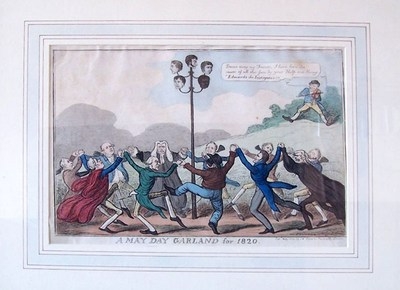
William Davidson
William Davidson was born in the 1780s in Jamaica. According to some accounts he was the illegitimate son of the Jamaican attorney general and a local black woman. At the age of 14 he was sent to Scotland to study law and was later apprenticed to a lawyer in Liverpool. After three years he ran away to sea and later was press-ganged into the Royal Navy.
On discharge he studied mathematics for a time before starting a cabinet-making business in Birmingham. When this failed he moved to London and married a widow, Sarah Lane. He also became a Methodist and taught for a time. He became involved in radical politics after the Peterloo Massacre in 1819, joining the Marylebone Union Reading Society, where he was able to read the radical press. He also became active in the Shoemakers' Union.
It was at the Marylebone Union that Davidson met John Harrison, a Spencean (a member of the Spencean Philanthropists) and joined as well. He met Arthur Thistlewood and was swiftly enrolled onto the Committee of Thirteen that ran the organisation. Davidson agreed to join Thistlewood and twenty-seven other Spenceans in a plot to kill government ministers dining at Lord Harrowby's house on 23 February 1820. The conspirators assembled in a hayloft in Cato Street, near Grosvenor Square in London. However, the ministers were not at the house and it was a trap. George Edwards, a member of the group, was in fact an agent provocateur working for the government.

May Day Garland for 1820 cartoon showing head of William Davidson
Police officers arrived and after a fight in which one officer was killed, the Spenceans were arrested. On 28 April 1820, William Davidson, James Ings, Richard Tidd, Arthur Thistlewood and John Brunt were found guilty of high treason and sentenced to be hanged, drawn and quartered.
William Davidson and the others were hanged outside Newgate Prison on 1 May 1820. After being hanged they were beheaded but not quartered. Six other men were transported.
Resources about William Davidson and the Cato Street Conspiracy in our collection
The Library has a very good collection of primary and secondary sources on radical movements of the late 18th Century and early 19th Century of which the Cato Street Conspiracy was just one episode.
The Cato Street conspiracy is dealt with directly in the following works:
Edward Aylmer, Memoirs of George Edwards, alias Wards, the acknowledged spy, and principal instigator in the Cato-Street plot ... in which the various machinations of this desperate character ... are impartially detailed and made public through Alderman Wood, M.P. ...: to which is added, and account of the lives and trials of the five deluded men who were beheaded on Monday, May 1 (1820) - Shelfmark: D31
FW Chandler, Political spies and provocative agents (1936) - Shelfmark: D20
John Stanhope, The Cato Street Conspiracy (1962) - Shelfmark: D20
George Theodore Wilkinson, An authentic history of the Cato-Street conspiracy: with the trials at large of the conspirators, for high treason and murder; a description of their weapons and combustible machines, and every particular connected with the rise, progress, discovery, and termination of the horrid plot. With portraits of all the conspirators, taken during their trials, by permission, and other engravings (1820) - Shelfmark: D31
The Library has the complete transcript of the trial of William Davidson (State Trials, Vol 33 - Shelfmark: D33) and also a contemporary satirical radical cartoon entitled A May Day Garland for 1820 (see image above) showing the heads of the executed men on a Maypole whilst the judges and aristocracy dance around it and the government agent Edwards plays the fiddle.

